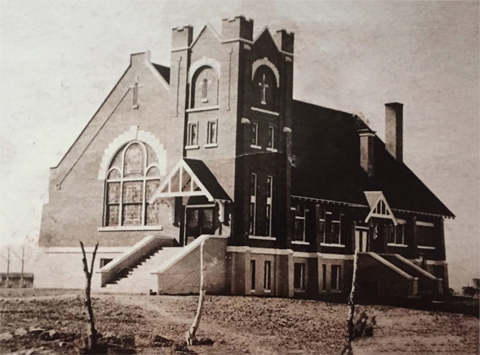By Gwenfred J. Crowther
In the Spring of 1867 a group of the pioneers of the Malad Valley met and came to the conclusion that a flour mill was of vital importance to the community. They checked the possible locations and the various streams as a possibility of water power running the mill and doing the grinding of the wheat. After making a survey, they found that by turning the Cherry Creek which was then running into the Marsh Valley, and combining it with the streams now known as Devil Creek on the Malad Valley side, it would be possible to use the water power for running a grist mill and also for a saw mill, which was greatly needed for the production of lumber for the building of homes and public places.
John Nelson became interested and directed the building of the flour mill. He secured the necessary machinery, including an overshot water wheel and the necessary ditches and flumes for the power. John J. Williams surveyed the ditch for diverting the stream over the Malad divide and used a common spirit level, the only surveying equipment available at that time. He was assisted by such men as Dan Daniels, James E. Jones, William Williams, William Gualter and others.
John Nelson was owner for four or six years, then a cooperative milling company was formed and he sold the flour mill to them in 1873. John J. Williams, John W. Lusk, and John Price, were the officers of this milling company.
They operated the mill until 1877, then they sold it to the Malad Co-Operative Company on account of extra capital needed. The t;rustees of the Malad Cooperative Company at that time were Thomas W. Thomas, L. J. Bolingbroke and Christopher Ceaston.
In 1880 the officers of the Malad Co-Operative Company were changed and Jenkin Jones became president, and Isaac Jones became secretary. In 1884 D. L. Evans replaced secretary Isaac Jones as John L. Roberts, James P. Harrison and George Stewart became active in the company.
At this time there was considerable activity in the milling business in Malad on account of the freighting carried on through Malad Valley between Corrine, Utah, the railroad connection on the south, and Butte, Montana which was active in mining. In about 1885 one-half interest in the flour mill was sold to Peter Hansen, who took over the management of the mill. In 1886 he bought the other half interest and continued to operate the mill until 1890.
Peter Hansen sold the entire property in 1890 to William E., John E., and Daniel E. Jones. At this time the new owners decided to rebuild and modernize the flour mill, installing all new machinery, building additional working space and changing the grinding from burr stones to the roller process. It was at this time also that the name was changed from Malad Flour Mills to Malad Roller Mills.
When the new mill was started, they found that the water power was inadequate for the larger capacity, and it was necessary to supplement the water power with a steam engine and boiler. They found this was very costly to operate.
In 1893 the business was found to be insufficient to support the three brothers, so John E. and Daniel E. sold their shares to William E. Jones and he became the sole operator. In 1904 he was able to install a new pelton type water wheel and pipe line which developed two to three times the power of the discarded overshot water wheel. He operated the flour mill until 1912 when property was sold to the Crowther Brothers of Laketown, Utah.
Then again the mill machinery being 20 years old, and with the new type of flour milling machinery developed, it was necessary to completely replace the machinery and build more space for the operation of the new equipment. At this time also, a grain storage of 25,000 bushels capacity of wheat and ware house was built to operate on a merchant milling basis instead of purely a grist mill.
Two years later, with the new supply of electric power coming into the valley it was possible to take care of the further requirements of the community by installing a new feedmill and barley mill for steam rolling and grinding grains for feed.
As business increased it was found necessary to further expand, so in 1927 the company added an additional 40,000 bu. of wheat storage, and remodeled the flour mill as well as building the railroad to the plant, making it possible to ship flour and grain directly from the flour mill plant.
In 1940 because of increased grain production in the area, an additional 225,000 bushels of storage was built. And another 300,000 bushels of storage was built in 1948. The water reservoir was also built at this time which doubled the water power for the mill, and was of great value as water storage for irrigation purposes.
The mill has constantly been improved and capacity increased, until the products are sold in many of our western states and in addition to the demand for family flour for domestic use, there is a big demand for bakers flour and macaroni flour. In fact a great deal of Durum wheat is now moved in from Montana for the manufacture of the highest grade of macaroni flour.
For the past 25 years the hard wheat flour has been packed in cans for home storage and for the armed services to be consumed in all parts of the world.
(picture of the mill on the back)
